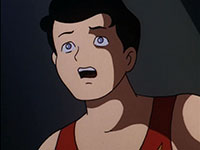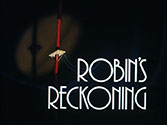|
 Like
the puppy that poops on your least favorite rug—and thereby gives
you an excuse to throw it out—sometimes the censors crap on just
the right scene. Their fortuitous objections to the Flying Graysons' explicit
death pushed the producers into constructing one of the most understated
yet powerful scenes in the series. High above the ground, the Graysons
swing back and forth on a trapeze. Above them, the rope they dangle from
begins to fray. They don't see it, but young Dick does. He calls to them.
There's an ominous pause as their silhouettes swing out of the frame.
Then a crash of horns as only the broken rope swings back into view. The
audience gasps in horror, and a tasteful dissolve takes us to the next
scene. Like
the puppy that poops on your least favorite rug—and thereby gives
you an excuse to throw it out—sometimes the censors crap on just
the right scene. Their fortuitous objections to the Flying Graysons' explicit
death pushed the producers into constructing one of the most understated
yet powerful scenes in the series. High above the ground, the Graysons
swing back and forth on a trapeze. Above them, the rope they dangle from
begins to fray. They don't see it, but young Dick does. He calls to them.
There's an ominous pause as their silhouettes swing out of the frame.
Then a crash of horns as only the broken rope swings back into view. The
audience gasps in horror, and a tasteful dissolve takes us to the next
scene.
This is the artful
way things would have been handled back in the days of the Hays Office,
too, when gangster flicks like Public Enemy, The Roaring Twenties
and White Heat got by on style rather than overt violence. The
virtues of "Robin's Reckoning" are also very old-fashioned.
It's full of the same scene-chewing, foot-stomping melodrama that Warner
Bros. used to pour out of a dump truck and into its gangster dramas and
backstage musicals; when young Dick Grayson takes to the streets in an
oversize sweater and floppy cap he looks like he's trying out for a revival
production of a Dead End Kids flick. And when he catches up to Tony Zucco
you know exactly what is going to happen next because its the kind of
thing that always happens in these melodramas: Zucco will corner him,
he'll be rescued by Batman, and then he'll do something stupid like fall
in the river so Batman will have to let Zucco go in order to save him.
Unfortunately, its
weaknesses are also very old-fashioned—it's sometimes very clunky.
When everything happens on the surface, like it does here, there's no
point in complaining about a lack of attention to psychological detail,
but this one seems to miss even obvious opportunities. Case in point:
When young Dick first arrives at Wayne Manor, we get a point-of-view shot
of its imposing facade receding vertiginously skyward; later, Alfred must
intervene to get Bruce to pay attention to his young charge. The implication
is that the boy is lost in that empty mansion. And yet the one shot that
would have established the point is entirely missed. "This is the
room Master Bruce slept in when he was your age," Alfred announces
to Dick, and we get a close look at Dick's face as he gazes around. But
we don't see what he sees: the vast, cavernous, alien space. That single
uninserted shot would have sealed the deal: in one stroke we would have
seen the emptiness on his inside dramatized by the emptiness on the outside.
And Wayne's tactlessness—what young child was, or could have been,
happy in that tomb-like space—would have been on full display and
a prime source of tension—can Wayne and Grayson ever truly come to
an understanding?—would have been ratched up.
 A deeper problem
is that of misplaced conflict. Grayson bears a grudge against Zucco and
wants to catch up to and punish him. That's a given, but there's nothing
in that conflict to develop or complicate, so there's no real point in
dwelling on it. Instead it's merely a goal for Robin to reach, and the
real conflict is with the person keeping him from that goal: Batman. In
counterpoint to this surface conflict is a fascinating subterranean one,
only glimpsed here, back in that empty house where Grayson mopes around
unhappily. The implication is that, both before and after he takes a direct
interest in Dick's happiness, Wayne is an impediment to his natural growth.
Before: Wayne abandons Dick to the empty manor, leaving him alone, unloved,
and just short of unwanted, in marked contrast to the warm and happy troupe
he left behind at the circus. After: Wayne treats Dick as a training partner
and then as subordinate crime fighter, with the implicit promise that
under his tutelage he will be able to find and capture Zucco, but then
denies him the opportunity. In each case, he promises Dick something he
needs—a home or a chance at his parents' killer—and then tries
to deny it. A deeper problem
is that of misplaced conflict. Grayson bears a grudge against Zucco and
wants to catch up to and punish him. That's a given, but there's nothing
in that conflict to develop or complicate, so there's no real point in
dwelling on it. Instead it's merely a goal for Robin to reach, and the
real conflict is with the person keeping him from that goal: Batman. In
counterpoint to this surface conflict is a fascinating subterranean one,
only glimpsed here, back in that empty house where Grayson mopes around
unhappily. The implication is that, both before and after he takes a direct
interest in Dick's happiness, Wayne is an impediment to his natural growth.
Before: Wayne abandons Dick to the empty manor, leaving him alone, unloved,
and just short of unwanted, in marked contrast to the warm and happy troupe
he left behind at the circus. After: Wayne treats Dick as a training partner
and then as subordinate crime fighter, with the implicit promise that
under his tutelage he will be able to find and capture Zucco, but then
denies him the opportunity. In each case, he promises Dick something he
needs—a home or a chance at his parents' killer—and then tries
to deny it.
Dick correctly sees
Batman as the problem, and at the end of Part One threatens to break with
him. With this conflict in place, Part Two should have been devoted to
the contest of wills between protagonist (Robin) and antagonist (Batman),
with the former desperately trying to get at Zucco as the latter just
as desperately tries to keep him away. There's some of that here, but
our two heroes (cast on opposite sides of the conflict) don't close quarters.
The proper climax would have had Robin fighting his way past Batman to
get at Zucco, or had Batman explicitly step aside so that Robin could
find his own way. But the series was—at this point, at any rate—unwilling
to jeopardize their relationship, and so, having kindled a fire between
them, hurried to put it out and kick over the traces.
This, it must be
said, is very much not an old-fashioned aspect of the story. When
Cagney or Bogie or Eddie G. walked into a room for the final confrontation
you knew only one person was going to walk out. The sentimental tie that
keeps Robin and Batman together here would not have been out of place
in those melodramas either; on the contrary, they sharpened their conflict
by pitting friend against friend, brother against brother, son against
father, so that the final resolution, happily or not, would have maximum
impact. It's a pity than in a comic-book melodrama, which has even more
room for histrionics, they weren't quite so trusting of the material.
|



